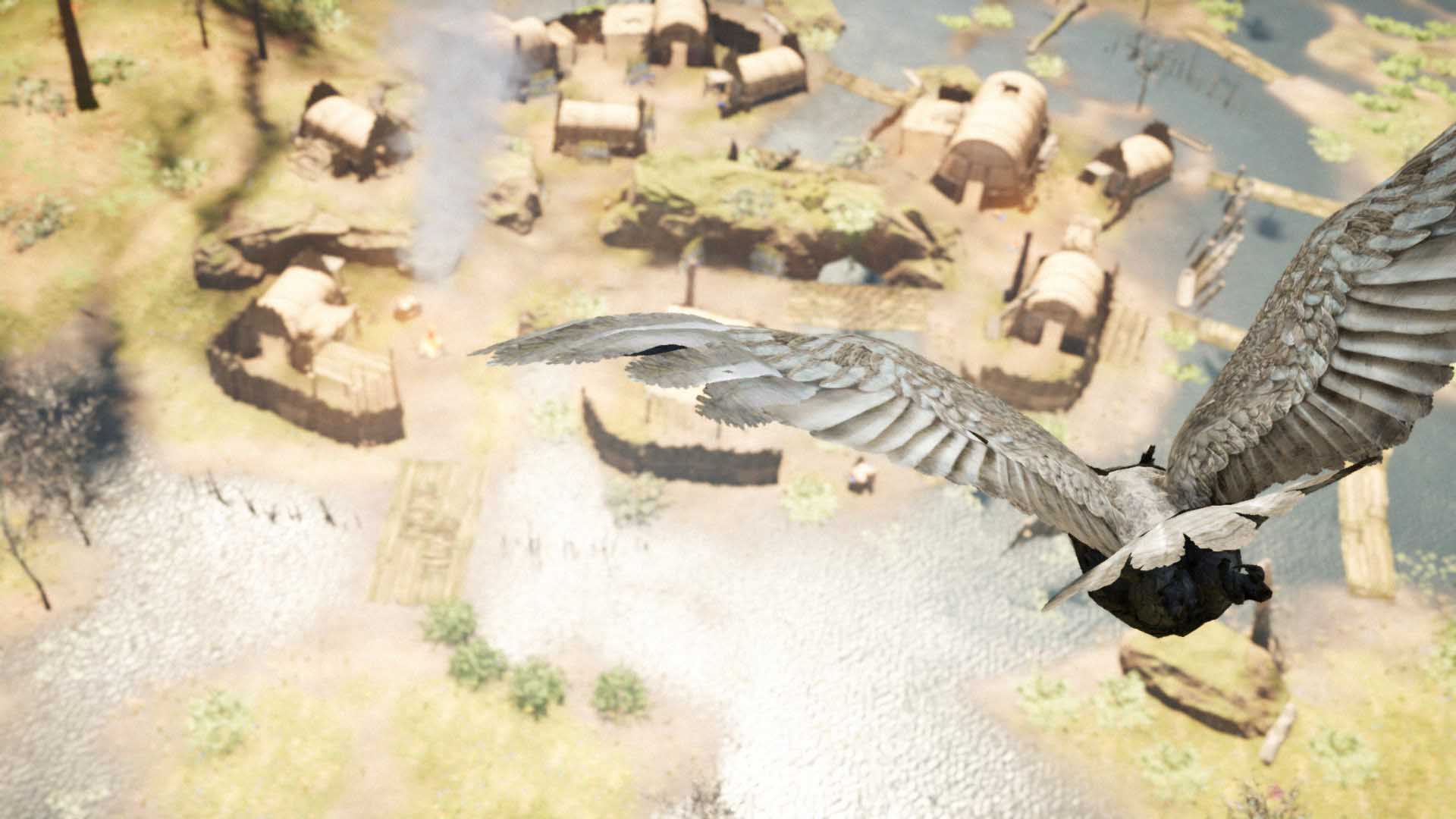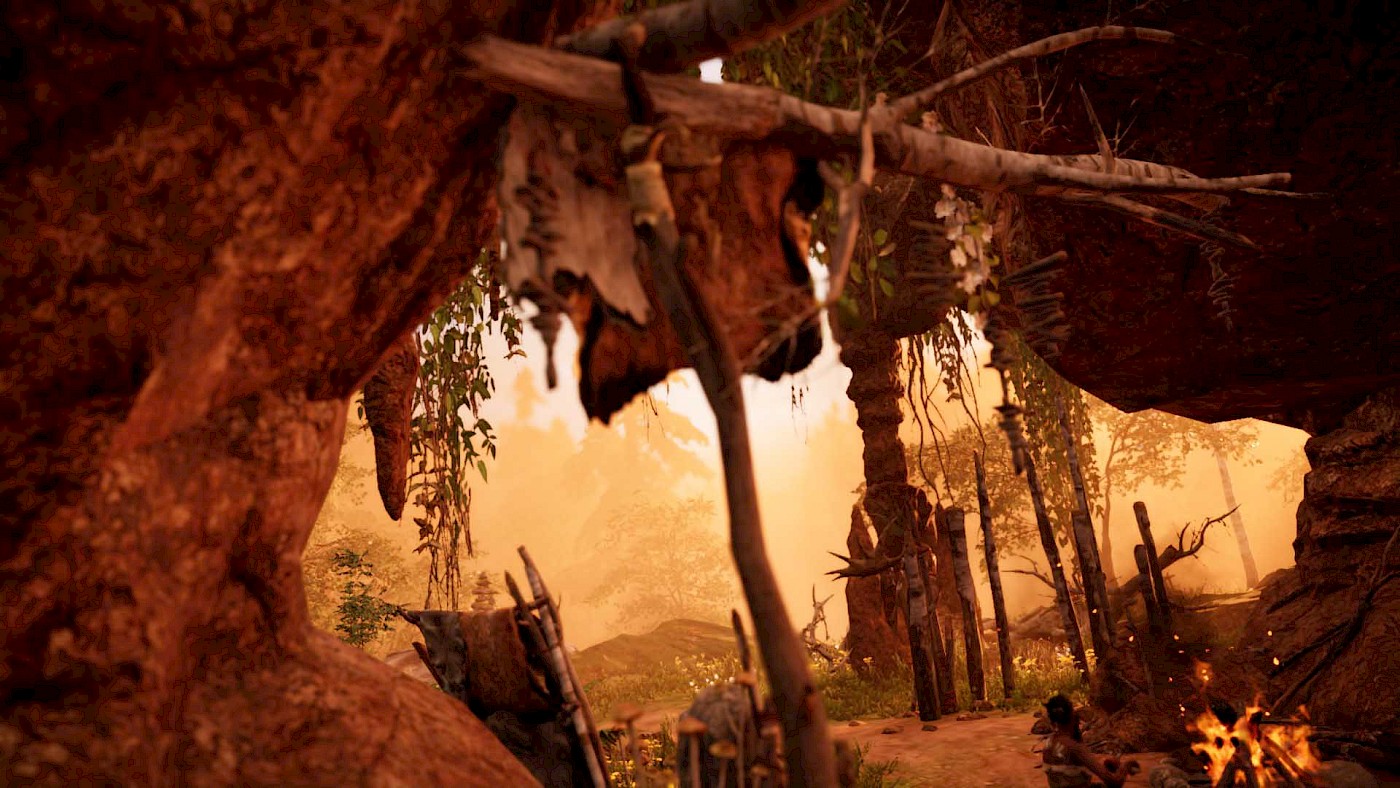Things are moving along nicely in the valley of Oros. As you may remember, I started out my adventures in Tutorial Land, rescued the somewhat mentally disturbed Sayla, brought Tensay the shaman to our village, tamed a wolf, expanded the village some more, spent some quality time with the local wildlife, and then met Batari, the leader of the Izila tribe. Last time, I decided to go and capture one of these ‘fire walkers’ to add to our tribe.
As was the case with Dah, capturing Roshani requires me to assault a heavily defended fort. This Izila location is located far to the south of the Udam fort where I found Dah, but by now I have captured so many rival outposts that I can easily bounce between fast travel locations. However, I expect heavy resistance. Since I died multiple times in my attempt to acquire Dah, I have no doubt that the same will happen in this case.
And I’m not disappointed. The Izila fort is located in a marshy area, nestled against rocky cliffs, and can be assaulted from basically one direction. There are towers with lookouts that hurl missiles when you get close, and there are also more of the heavy fighters here that can stand up to quite a beating. The first few times, I tried a sneaky approach, remaining hidden for as long as I could and relying on my owl and sabretooth tiger to take care of the enemies. But these attempts all ended in failure. Sooner or later, I would be cornered and slain. Clearly, I need to change my tactics.

First, I decide that I need to unlock more skills to improve my chances. Most notably, I want to be maximize my ability to tame animals, so I can add a cave bear to my menagerie. I have the feeling I will need it to break through the Izila defences and get my hands on Roshani. I also want to upgrade the huts of my specialists in the village, as well as my own cave, since these net me large amounts of experience points. All this means running around the world, accomplishing various tasks, gathering resources, hunting animals, and so forth.
I like how the game handles these aspects. For most of our history, humans have been hunter-gatherers. Exploring is in our blood; it’s why many of us enjoy travelling or even simply going for a walk. The same goes for collecting: there’s a hunter-gatherer in every single one of us, who enjoys just collecting stuff. Whether it’s postage stamps, comic books, or different varieties of coloured leaves (as in Far Cry Primal), it doesn’t really matter. This basic drive, to explore an environment and to gather stuff, is what open world games rely on for their success. Far Cry Primal is no different, except that the theme fits just right with the game’s mechanics.
Even games that don’t feature open worlds often still appeal to these basic human tendencies. Think about achievements in games. For those who might know, an achievement is awarded for players who do something. Sometimes reaching the next chapter in a linear story-based game unlocks an achievement. Other times, performing a particular task or collecting a certain number of specific types of objects yields an achievement. It’s what drives many people to play through a game and explore every nook and cranny, just to be able to get all achievements. Again, it appeals to the inner hunter-gatherer.

When you travel around Oros, you will also discover various landmarks. The one depicted above I thought was especially striking: it’s a circle of standing stones, very similar to Stonehenge. The only problem, of course, is that Stonehenge dates from much later. Göbekli Tepe, the site that I referred to in an earlier instalment, is an older ritual site that dates to the tenth to eighth millennium BC and also featured monumental stone architecture. Unlike Stonehenge, which was built by farmers, Göbekli Tepe was constructed by hunter-gatherers. So it might be argued that perhaps the people of Oros, advanced as they seemingly are, could have erected something similar in 10,000 BC, even if nothing like it is known from Palaeolithic or Mesolithic Europe.
As a true hunter-gatherer, I wander the land of Oros in search of stuff to do (like Wenja side missions that pop up), resources to collect (like hardwood and clay), and animals to hunt (for hide and meat). Some of the things I need are difficult to obtain. To upgrade Takkar’s cave, for example, I need a few badger skins. Badgers are relatively small and hard to find in Oros. Curiously, they are also not available at night (despite the fact that badgers are actually nocturnal). Using my owl and hunter vision, I eventually manage to find the badgers I need and am able to upgrade the cave. In this way, I manage to upgrade quite a few of the huts in the village.
One of the (many) things the game does well is how it handles skills. As in many other games, you get experience points (XP) for doing certain things and completing tasks. Collect enough experience points, and you are awarded with a skill point with which to unlock a new skill. So far, nothing new. But in Far Cry Primal, skills are tied to characters. In order to get access to a particular group of skills, you first need to get the associated character back to your village (with the exception of basic “survival skills”, which are tied to Takkar and therefore unlocked from the start).

So, for example, beast master skills are tied to Tensay the shaman: according to the fiction, he is the one who teaches you to tame wild animals. It makes perfect sense within the setting of the game. In a world without writing, skills are passed simply from one person to the other. It makes sense that recruiting Dah to your cause would enable you to improve your fighting skills and unlock the ability to make (craft) some specialist Udam equipment. Crafting works the same as skills, though not all characters unlock new crafting recipes (e.g. Tensay doesn’t). The way that the game handles skills and crafting is an excellent example of how game mechanics can complement a game’s theme (and vice versa).
In any event, I finally manage to unlock new skills, including the ability to tame a cave bear. I check the map and find a location where cave bears are said to roam. It’s not difficult to find one: they are gigantic beasts. I throw some bait and then slowly approach the creature. In a matter of moments, I’ve succeeded in taming it. Feeling more sure of myself now, I return to the Izila fort, intent on destroying all opposition and capturing Roshani. But this time, I don’t want to storm the outpost directly. Instead, I use my arrows to raise the alarm and then lure the Izila defenders out into the marshy area.
Out in the open, my cave bear and I make short work of the Izila. With most of them dead, I head into the camp and kill whatever enemies remain. A few Izila are high up on a rock, loosing arrows or throwing spears in my direction. With my arrows I take them out one by one, until finally the last one is defeated. A cutscene plays in which I corner and capture Roshani (depicted a little above), who offers to teach me how to make fire bombs (a wholly fictitious prehistoric explosive). I lead him back to the Wenja village where, like Dah, he gets locked away inside a cage. Then, my attention is drawn to a marker that has appeared on Tensay’s hut. I wonder what’s next?
